Lots of first (and a couple of second) issues out this week, so let’s start with those:
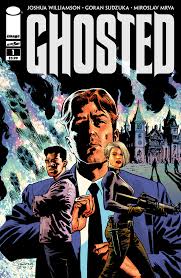 Ghosted #1 — Writer: Joshua Williamson; Art: Goran Sudzuka
Ghosted #1 — Writer: Joshua Williamson; Art: Goran Sudzuka
A very rich old guy breaks a criminal mastermind out of jail, to put together a team to enter a haunted house that’s about to be torn down, and bring back a real ghost from it. High-concept but kind of low execution, since if you poke at the plot it starts to unravel like a cheap blanket (if he’s that rich, why break the mastermind out in a bloody prison break? There are lots more subtle ways to do it… and, come to that, why not just buy the damn haunted house?), and this first issue mostly sets things up, with nothing supernatural until the last page. Still, there’s a nice-looking double-page splash of the rotting mansion that’s encouraging, and the whole Haunting of Hell House bit makes it worth coming back to, if only to see how imaginatively the various characters will be dispatched. Will this become a fun, bloody romp or a boring rehash of slasher cliches? Time will tell….
Sheltered #1 — Writer: Ed Brisson; Art: Johnnie Christmas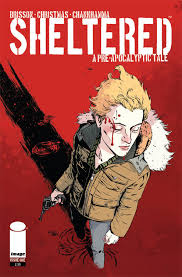
Another high-concept first issue: a survivalist community has been getting ready for the apocalypse (or, at least, one of many possible apocalypti), but their kids, for reasons not revealed in this first episode, decide to take matters into their own hands…. Brisson’s recent Comeback was a clever little sf/time travel mini-series, and Christmas shows some nice design touches in the art here, and pulls off a couple of nice effects with the faces; although one issue isn’t enough to get very invested in the characters, and this could easily become a poor man’s Lord of the Flies, it, like Ghosted, shows enough potential to make the second issue worth a look.
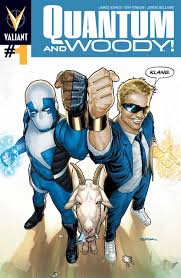 Quantum and Woody #1 — Writer: James Asmus; Art: Tom Fowler
Quantum and Woody #1 — Writer: James Asmus; Art: Tom Fowler
The original Q&W appeared in the late ’90s, and was one of the bright spots in that era’s incarnation of Valiant comics: written by Christopher Priest and drawn by Mark Bright, it was a sardonic take on the superhero genre, and at heart a mismatched-buddy tale of two bickering best friends, reportedly modeled on Priest’s and Bright’s own relationship. Clever and fun, it used sophisticated narrative techniques and had a lot of heart, and featured the two creators in seamless partnership, at the top of their games.
Naturally, the new Valiant has brought it back (through typical corporate sleight-of-hand, the company, not Priest and Bright, somehow owns the rights to the book), but with brand-new creators, and this first issue is a retelling of the duo’s origin. Bring back a comic that was known as the perfect expression of a very individual creative team, but without those original creators? What could possibly go wrong? Inevitably, everything: Asmus copies Priest’s original narrative tricks without understanding why they worked in the first place, and Fowler, while Ok on the superhero/action stuff, can’t match Bright’s abilities with faces, and fails to render the two lead characters with the affection or the attraction that the original book did. Do yourselves a favor and pick up the original series (the books are still widely available here at AABC, and for less than the new ones), and avoid this shambling, reanimated corpse.
The Shadow/Green Hornet: Dark Nights #1 (of 5) — Writer: Michael Uslan; Art: Keith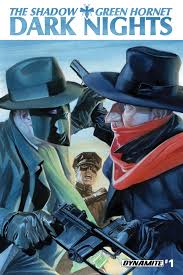 Burns
Burns
Uslan’s been at this a long time, and certainly knows his way around ’30s pulp tropes — there’s a page of footnotes at the end to explain many of the historical references, and I particularly liked the idea that the Nazis would consider the Green Hornet (who’s supposedly a criminal) as an obvious ally because of his “Japanese assistant,” but other than people who grew up in the ’30s and ’40s (not many of them left, and the ones who are aren’t much into buying comics), or late baby boomers, I can’t see much of an audience for this: to modern readers, the Hornet just seems like a cheap Batman riff, and the Shadow, while more intriguing, has been overexposed by Dynamite lately. Absent art by someone like Alex Ross (Burns is fine, and even stylish, but he isn’t going to draw in new readers by himself), this is just another rehash of 80-year-old plot points and characters, with slim hope of finding a solid footing in today’s market.
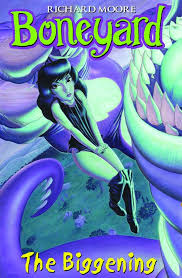 Boneyard: The Biggening #1 — Creator: Richard Moore
Boneyard: The Biggening #1 — Creator: Richard Moore
This is a reintroduction of Moore’s series about a guy who inherits a small-town graveyard, and finds it inhabited by all manner of creatures: a werewolf, a witch, a Frankenstein’s monster type married to a nymphomaniac Creature From the Lost Lagoon merwoman, a sexy vampire (whom he falls in love with), etc. It ran for a couple of years in the mid- ’00s, and was clever, imaginative, sometimes dramatic, often funny, and always fun. Moore’s tried a few other things in the intervening years, but none has stuck, and this remains his best work (although I have a soft spot for his earlier Tolkien-meets-the-American-frontier mashup, Far West), so it’s good to see him return to it. This one-shot, featuring an all-new story, should give readers a good example of the book’s charms; let’s hope it sells well enough to launch an ongoing revival.
Killjoys #2 (of 6) — Writers: Gerard Way and Shawn Simon; Art: Becky Cloonan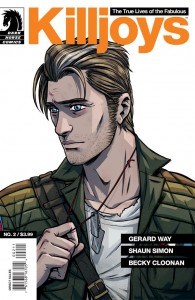
Lots of pop-culture stars try their hands at comics at some point, but Way, who fronted the group My Chemical Romance until it disbanded this year, is the rare one who can actually write, and is able to attract great artists: his Umbrella Academy of a few years ago was an imaginative sf/fantasy book with art by Fabio Moon and Gabriel Ba, and this new effort, a post-apocalyptic tale set in the inland desert northeast of LA and involving rebels against a regimented city, boasts work by Becky Cloonan, the highly-respected indy artist, who’s perfect at the kind of gritty backdrops and young-but-lived-in faces required here. Like Umbrella Academy, this is a complicated story, with a lot of moving parts; it’s moodier and quieter than that earlier work, too — although that doesn’t make it worse, just different, and a good advertisement for Way’s ability to handle different narrative tones.
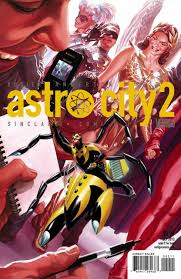 Astro City #2 — Writer: Kurt Busiek; Art: Brent Anderson
Astro City #2 — Writer: Kurt Busiek; Art: Brent Anderson
This second issue of Busiek and Anderson’s revival of their long-running series is a good example of their ability to humanize superhero stories: it focuses on a young woman who gets a job as a dispatcher, working on a hotline set up by the world’s JLA-type heroes to handle various emergencies. It’s a well-thought-out look at the pressures of such a job (for one thing, how do you sort out the 99 false alarms from each legitimate call, or live with the guilt if you mess up?), and, like most Astro City issues, makes its small-scale characters the focus, while the super-types and their conflicts take place off in the edges of the story. Busiek’s been masterful at this kind of human’s-eye view of a super-powered world since at least Marvels, and he and Anderson make this a smooth, well-told and compelling comic.
Superman Unchained #2 — Writer: Scott Snyder; Pencils: Jim Lee; Inks: Scott 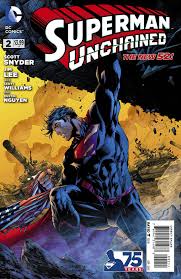 Williams
Williams
This is reminding me of the Brian Azzarello run on Superman #204-215 (now known as “Superman of Tomorrow” in its trade form); that had Jim Lee art, too, and was a highly-anticipated story from an author known for gritty noir books, who ended up crafting a too-long, too-grim, and too-confusing take on the Man of Steel that fell flat with fans. We’re only two issues in, of course, but this has the same government/military cynicism, the same sense of doom and gloom hanging over everything, and the same sense of too many pie plates spinning in the air at once. Here’s hoping Snyder proves to be more like, say, Geoff Johns, someone who can start out grim, but turn the corner and bring home a more hopeful and satisfying narrative, one where all the parts click unexpectedly into place and show a clear idea about what makes this character’s hopeful world so different from, say, Batman’s.
 Justice League #22 — Writer: Geoff Johns; Pencils: Ivan Reis; Inks: Joe Prado and Oclair Albert
Justice League #22 — Writer: Geoff Johns; Pencils: Ivan Reis; Inks: Joe Prado and Oclair Albert
Speaking of which… here’s Johns with the first chapter of “The Trinity War,” a clash between the various Justice Leagues (plain, of America, and Dark), set off by Captain Marvel’s good intentions, which trigger an international incident. It’s the kind of summer blockbuster event that’s loud, hectic and highly-hyped — and, in the right hands, a lot of fun. This first part sets up all the pieces, provides a set of reasonably logical misunderstandings to explain the tensions between the groups, and then offers some fighting, some shocking events, and a last-page reveal of (one of) the main bad guys. As I said, Johns is an old hand at this, and he and Reis provide a smooth, cinematic ride with enough thrills to justify the readers’ investments of time and money. For a first chapter, you can’t ask for much more than that….
Young Avengers #7 — Writer: Kieron Gillen; Art: Jamie McKelvie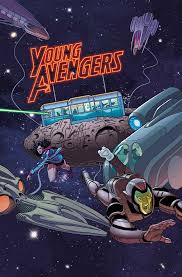
This creative team is reminiscent of some of the other top-tier Marvel books right now, like Fraction/Aja on Hawkeye or Waid/Samnee on Daredevil, in that the writers are expert at both character and continuity, and the artists have clean, arresting styles that mix retro charm with a modernist polish. There’s a lot of fun experimentation with the page layouts in this book, too: witness the social-media fill-ins, or the head-shaped pages, or the dimensional-transport shattered page: these are guys telling a good story, and having fun while they’re doing it. If you like Hawkeye or Daredevil, do yourself a favot and try this book: it deserves a seat at that fan-favorite table, too.
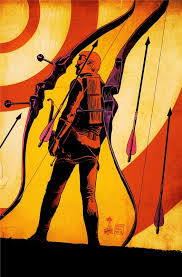 Hawkeye #12 — Writer: Matt Fraction; Art: Francesco Francavilla
Hawkeye #12 — Writer: Matt Fraction; Art: Francesco Francavilla
No Aja this issue (hey, after last month’s “Lucky the Pizza Dog” spotlight, he deserves a rest), so Francavilla provides the visuals for a story about Clint’s older, and shadier, brother Barney. We saw some of this from Lucky’s POV last time (it looks like that book provided a shorthand, dog’s-eye view of the next couple of issues’ events), but now we get if from Barney’s, along with a couple of flashbacks to the kids’ childhood. That’s a little angsty (and pathos-y) for my taste, but it gives a chance to see how Barney is both alike and unlike Clint, and as a small break from the regular action, and a separate pice of the overall puzzle, it does just fine.
Daredevil #28 — Writer: Mark Waid; Pencils: Javier Rodriguez; Inks: Alvaro Lopez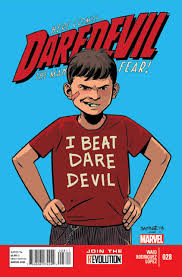
Another book minus its regular artist (although, like Aja in Hawkeye, Samnee will be back next issue); Francavilla isn’t quite as good, but is more than decent, and certainly knows his way around the character, so a jarring transition is avoided. This is the start of a new story, involving a now-grown-up kid who used to bully the young Matt Murdock, and shows up needing legal help. Waid does an interesting take on the character, avoiding the afterschool-special cliches about bullying that must have been tempting to throw in; instead, he has the guy point out that the young Matt was kind of a pain in the butt himself: a good example of Waid’s thoughtful approach to plotting. Let’s hope it carries over to the bad guys: the Sons of the Serpent, Marvel’s KKK wanna-bes whose racist rants might have seemed more realistic in the ’60s, but have grown increasingly cartoony over the years; making them credible opponents in a modern comic might tax even Waid’s abilities.
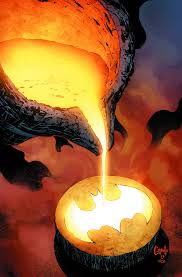 Batman #22 — Writer: Scott Snyder; Pencils: Greg Capullo; Inks: Danny Miki
Batman #22 — Writer: Scott Snyder; Pencils: Greg Capullo; Inks: Danny Miki
Continuing Snyder and Capullo’s latest arc, “Zero Year,” a flashback story about a Bruce Wayne who’s young, back in Gotham and starting out as a vigilante, but hasn’t had a bat fly in his window to inspire him to create a costumed identity yet. As has been the case since this “New 52” series began, it’s well thought out, looks good, and gives readers plenty of little character bits and lots of nice-looking action. Batman is the industry’s best-selling comic right now — and has been for a while — and dependably-entertaining issues like this make it easy to see why.
Uncanny X-Men #8 — Writer: Brian Michael Bendis; Pencils: Chris Bachalo; Inks: Tim 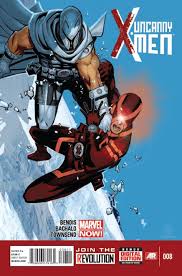 Townsend
Townsend
If you’re keeping a scorecard, this is the Bendis X-book that (a) focuses on the Cyclops/Magneto fugitive team and how they’re rescuing/recruiting new mutants to train/help their cause, and (b) has consistently-awesome Bachalo art. The racist (mutist?) reactions to the new kids as they manifest their powers are starting to get old (nobody anywhere — no cop or passerby, certainly, and only the rare family members — ever seems to sympathize with or encourage these kids, except for Scott and his crew), but that’s my only complaint; otherwise, it’s the regular Bendis mix of good dialogue and character interaction, with Bachalo making it very easy on the eyes.



